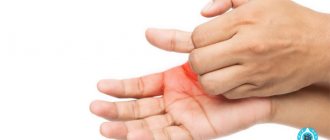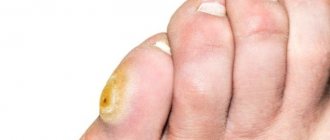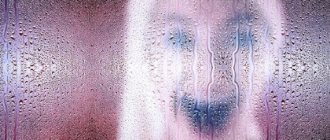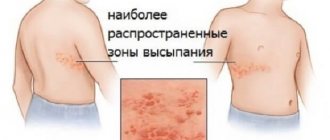Pimples on the legs may be itchy or not cause discomfort. But in any case, their appearance cannot be ignored. The reasons for changes in the skin vary: from minor irritation, which goes away in a couple of days, to serious pathologies of internal organs. Therefore, when pimples appear on the legs and itch, it is better to check with a doctor if there are no provoking factors.
Kinds
In women, similar symptoms often develop during hair removal. After shaving, the skin may become covered with minor red pimples.
Acne on the legs appears due to improper hair removal, wearing too tight clothes, allergies, herpetic rashes, etc.
Symptoms may vary depending on the cause of acne. Diagnosis is carried out to determine the provoking factors.
Treatment: for herpes infection - antiviral drugs, immunomodulators; for purulent acne, antibiotics are prescribed; to eliminate itching - antihistamines.
In all cases, proper hygiene is indicated, as well as compliance with the rules for hair removal.
In addition, rashes can be triggered by a cold. Their formation is often observed in winter, when the immune system is significantly weakened. This period is a time of exacerbation of chronic pathological processes, including dermatological diseases.
Rashes on the legs can be a sign of serious diseases: lichen planus, necrobiosis lipoidica, and so on.
If a rash appears on the lower extremities, it is important not to self-medicate, but to immediately consult a dermatologist.After a complete diagnosis and timely diagnosis, the result of treatment will not be long in coming.
Dermatovenerologist, cosmetologist
Zhikhoreva Inna Viktorovna
6 years experience
Traditional methods
Homemade recipes for some people completely eliminate the problem, while for others they add complications. Therefore, the planned use of any means should be agreed with the doctor, with the exception of treating mild allergic rashes with decoctions of pharmaceutical preparations.
- To eliminate itching and heal small pimples, baths, compresses, applications of chamomile, calendula, nettle, oak bark, string, and sage are recommended. The procedure depends on the location of the pimples. A decoction is prepared from one herb or mixture. Dip your feet into the filtered and cooled liquid or soak a gauze pad and apply to the affected area for 15 minutes.
- For molluscum contagiosum:
- chop the garlic, mix with butter and apply to the nodules,
treat pimples with celandine juice,
- apply a tampon soaked in a saturated solution of potassium permanganate,
- treat with apple cider vinegar.
- For scabies, rub your feet with lard.
- For allergies and hives, it is recommended to take castor oil to cleanse the intestines, and an infusion of lemon balm, linden or mint to calm the nerves.
All of these products are aggressive and can cause burns. When processing, care must be taken to ensure that healthy skin is not touched.
Read also: Itchy eyes and swollen eyelids: reasons. How to treat itching, redness
External causes of acne can be excluded if you do not forget about prevention. Increased hygiene, compliance with precautions in public locker rooms will reduce the risk of infection, good cosmetics and detergents, clothing and shoes made from natural materials, a suit for the weather, and shoes that fit properly will prevent allergies and urticaria.
Watery pimples
Watery pimples on the lower extremities are observed during the cold season. Their occurrence is due to serious pathological processes inside the body.
Many people do not pay due attention to this phenomenon. However, the risk of the rash spreading and worsening increases.
Often the rash is associated with skin allergies to cold and irritation from clothing.
How to get rid of acne quickly
Acne is a common skin problem, affecting about 85 percent of the population.
In addition, experts observe a deterioration in the functioning of the immune system during this period. Therefore, viral pathological processes in the skin begin to activate.
Particular emphasis on the occurrence of a rash should be given to people with pathological processes in the gastrointestinal tract. A red rash will be a harbinger of problems within the digestive organs.
Dry, purulent and subcutaneous acne
They are invisible to the patient, since the tumors do not cause pain or cause physical discomfort. But after identifying a rash, a person may develop psychological complexes.
Most people mistakenly believe that dry acne can be easily eliminated. During trauma to the apexes, the infection penetrates inside, and therefore inflammation can develop.
Purulent rashes on the lower extremities are the result of a bacterial infection in the body. It is associated with skin diseases. However, often such a rash indicates malfunctions in various organs within the body.
Subcutaneous rash is considered the most dangerous type of this disease. When there are too many of them, this indicates dangerous hereditary pathological processes. Therefore, you must definitely consult a specialist.
Rash between legs
A red rash on the lower extremities may be noted on the inner thighs. Often it begins to itch, since the skin in these areas is characterized by hypersensitivity.
When a patient suffers from excess body weight, the problem may worsen due to constant mechanical friction. As a result, inflammation occurs.
Such acne may appear due to:
- incorrectly chosen underwear ( wearing fabrics made of synthetic material);
- allergies to household chemicals;
- high blood sugar
- activity of molluscum (a viral skin disease that is transmitted by contact);
- genital herpes (white blisters in the groin, on the thighs inside and outside).
Rash on feet
A rash on the feet does not form due to the influence of unfavorable circumstances. They are associated with a variety of dangerous violations. Common acne or comedones cannot appear in this area, since there are no sebaceous glands on the sole.
Why can our articles be trusted?
We make health information clear, accessible and relevant.
- All articles are checked by practicing doctors.
- We take scientific literature and the latest research as a basis.
- We publish detailed articles that answer all questions.
When a patient has identified a rash on the fingers, back or sole of the foot, he should consult a dermatologist.
Dyshidrosis can form on the feet. In many situations it is discovered in the warm season. The rash itself appears as small red blisters.
The root cause of dyshidrosis is considered to be an irritating substance. Often the skin of the lower extremities comes into contact with household chemicals, soap, and powder.
How to get rid of acne marks
Facial rashes are a common problem that almost every person faces.
The resulting bubbles begin to burst during increased friction. As a result, the liquid flows to the surface. The patient, in addition to rashes, feels a high body temperature.
During the period of itchy dermatitis, the rash on the legs is associated with intense itching. Pimples have a watery texture. The rash forms after consuming antibiotics, contact with household chemicals, overheating and squeezing the lower extremities with shoes.
Getting rid of pimples in the perineum
The skin on the inner thigh is the thinnest and is very vulnerable. Most overweight people suffer from acne in this part of the legs.
To prevent skin rashes, women should be extremely careful when depilating in this area.
Before you start getting rid of acne between your legs, you should determine the true cause of their appearance. Symptoms often occur due to:
- Incorrectly selected underwear. You should avoid synthetic materials and fabrics that are too warm.
- Allergies. Acne may be a reaction to laundry detergent.
- Due to increased blood sugar levels. Sometimes diabetes is the cause.
- With molluscum contagiosum. This skin infection can easily be contracted in public places, when trying on clothes.
- Due to genital herpes. A blistering rash is considered one of the main symptoms of the disease. The affected area extends to the groin area, the inner and back of the thighs.
Rashes between the legs should not be ignored; symptoms are especially manifested by itching and enlargement of the affected area.
Causes
Among the most common provoking factors for the occurrence of rashes are the following:
- Inappropriate cosmetics. Irritation and acne can be caused by components included in gel, foam, cream and shampoo, the foam of which penetrates into the water during the process of washing the hair.
- quality . Water in open reservoirs contains harmful chemical compounds. A rash can form when visiting swimming pools where water is chlorinated.
- Epilation. In such a situation, the rash is caused by improper hair removal means or mechanical damage to the skin due to the blade while using a razor.
- Ingrown hair. In the area where the hair has grown into the skin, a small red bump forms. This is a side effect after shaving. To avoid such phenomena, you need to consult a cosmetologist. The doctor will give recommendations on how the procedure should be carried out and what care the skin needs to prevent ingrown hairs.
- Wrong clothes. Excessively warm, thick or synthetic clothing (including nylon tights) does not allow the skin to breathe. As a result, sweating increases, which causes clogging of pores and the formation of pimples.
- Allergic reaction. The occurrence of acne is associated with redness of the skin and intense itching. Clothing fabrics, food products, cosmetic preparations, household chemicals, etc. act as allergens. When measures are not taken in time, an allergic reaction can provoke more dangerous consequences - dermatitis and eczema.
- Colds . It is another common trigger for rashes on the lower extremities. Often the rash damages the skin during cold and damp seasons. During this period, the immune system is extremely weakened. Colds often appear, and chronic diseases, including dermatological ones, are exacerbating.
- Vitamin deficiency (small white pimples form) and hormonal imbalance (manifested by a rash and peeling of the skin).
Having accurately established the root cause of the disease, the specialist will be able to prescribe effective therapy.
Causes of water pimples
There are several main reasons for the formation of water pimples on the skin of the legs, let's display them:
- Allergy. This is one of the most common reasons, since there are many types of allergic reactions. This can be either a reaction to food or a rash that reacts to the composition of the fabric, contact with household chemicals, or intolerance to certain components in medications.
- Excessive activity of the sebaceous glands on the body. This reason is considered the most common.
- Dry skin. If the skin is overdried, then with constant contact with the fabric of clothing, natural abrasion of the upper layer of the skin occurs, which leads to severe irritation, which in turn leads to the formation of rashes.
- Problems with the functioning of internal organs. In this case, the rash acts as the first warning. The most common problems include variants with gastrointestinal diseases or hormonal imbalances.
- Yes, and hormonal imbalance can be tolerated separately. This can happen either due to injury or due to taking certain medications. At the same time, in adolescents, hormonal imbalance can be observed during puberty, and in women during menopause.
Symptoms
Skin changes on the lower extremities vary. They often manifest themselves as a rash on the legs, but there are other specific symptoms:
- Corky. Dense to the touch. They are characterized by a black or brown tint. They indicate recovery of the skin.
- Scales. Fragments of peeling skin.
- Stains. They change their color, but at the same time they are on the same level with the skin. They come in red and white.
- Papules. Areas of the skin that are much higher than other areas of the dermis.
- Plaques. They are fused papules.
- Vesicle. A small bubble filled with liquid.
- Pustule or abscess. Outwardly they resemble a blister filled with pus.
- Blister. An area of skin with a rough outer layer.
- Erythema. The part of the skin that rises above the rest. Has clear contours.
- Nodules. They are characterized by a certain change in the relief and shade of the dermis.
- Purpura. The most common injury to the lower extremities.
When initial symptoms appear, you should seek advice from a dermatologist.
Dangerous accompanying symptoms
When red bumps appear on your legs and itch, you need to carefully evaluate your general condition. Heralds of infections or serious pathologies of internal organs, along with changes in the skin, are:
- heat,
- dizziness,
- weakness,
- aching joints,
- enlarged lymph nodes,
- low blood pressure,
- blurry vision
- swelling of the legs.
Read also: Itchy heels at night: why your feet itch at the bottom in the evening, treatment
In addition, a common allergen can cause anaphylactic shock. And this is already a threat to life.
Diagnostics
Diagnostics is needed to accurately determine the provoking factors that caused pimples to form on the legs. The specialist directly conducts an external examination of the patient and prescribes clinical tests (general and biochemical tests of blood, urine, stool).
Initially, the root cause should be eliminated, and then the acne itself should be removed if the rash does not go away after treatment. These reasons differ for women and men.
In a situation where acne begins to itch, it is likely that they have formed as a result of allergies and, perhaps, antihistamines, tablets and ointments will be prescribed as treatment.
When a specialist determines that a rash on the lower extremities is formed due to an internal disease, complex therapy is prescribed in order to eliminate it. In such a situation, you will need to consult not only a dermatologist, but also specialized specialists.
How to get rid of acne on legs at home
Usually, acne can be removed from your legs at home by consulting a dermatologist.
Hygiene and proper nutrition
An important aspect in the fight against problem skin is following the rules of personal hygiene:
- Acne on the feet will not appear if you change your shoes to more comfortable ones that fit properly.
- Use high-quality personal hygiene products, try changing them to something new to avoid an allergic reaction.
- To improve the condition of the skin with ingrown hairs, it is recommended to exfoliate and treat the affected areas of the legs with soft scrubs.
- Be sure to shower daily, but do not use antibacterial soap.
Avoid salty, fried, peppered foods, as well as alcoholic and carbonated drinks. Eliminate foods containing large amounts of dyes and preservatives from your diet.
Medicines
To combat acne, try using salicylic ointment or salicylic acid in solution. These products effectively dry out acne. If acne is purulent, you can seek help from antibacterial drugs (Dalacin, Zinerit).
If problems do not go away within ten days, consult a dermatologist.
If you don’t know what to do with acne that is accompanied by itching, make an appointment with a doctor, and before that, use a hormonal remedy (cream, ointment based on glucocorticosteroids) to reduce the inflammatory process. Sinaflan, Gioksizon are suitable. Remedies that relieve itching and redness for any cause of acne on the legs are Radevit ointments (it contains vitamin A - retinol), Bepanten, Eplan. Ointments and creams Skin-Cap, Exoderil, Clotrimazole and Lamisil will help if the rash is caused by fungal activity.
ethnoscience
To eliminate pimples on your legs, rub the affected areas with herbal infusions, such as chamomile or calendula. There are other effective means:
| Components | Cooking method | Mode of application |
| Claryberry (20 g) and Chamomile (20 g) | Mix the ingredients and fill them with 250 ml of hot water. After an hour, strain the product. | Take 50 ml orally five times a day. |
| Viburnum (100 g) | Chop the berries and pour two cups of boiling water. Cover with a towel and strain after two hours. | Three times a day with meals, 40 ml. |
| Nettle (25 g), birch buds (35 g), calendula (10 g) | Pour two cups of boiling water over the ingredients. The product will be ready for use in two days. | Make a cotton-gauze bandage, soak it in the product and apply it to the affected areas of the skin. The duration of the procedure is an hour. |
Temperature control helps cleanse the skin. The temperature in the room should not exceed 24 degrees. Sweating will be reduced, so the pores will not be blocked. Please note: even before using folk remedies, it is recommended to consult a dermatologist.
Treatment
The dermatologist chooses the treatment regimen after establishing the origin and root cause of the rash.
Self-medication is dangerous with complications!
Attention
Despite the fact that our articles are based on trusted sources and have been tested by practicing doctors, the same symptoms can be signs of different diseases, and the disease may not proceed according to the textbook.
Pros of seeing a doctor:
- Only a specialist will prescribe suitable medications.
- Recovery will be easier and faster.
- The doctor will monitor the course of the disease and help avoid complications.
find a doctor
Do not try to treat yourself - consult a specialist.
It must be remembered that it is forbidden to press on the elements of the rash. This contributes to the appearance of adverse consequences and the spread of the rash to healthy areas of the skin.
It is possible to eliminate acne on the legs through a variety of local medications.
In addition to medications, ozone therapy is prescribed. It helps to increase blood circulation and the action of the active components of ointments. In this regard, recovery occurs much faster.
How to relieve acne inflammation
Acne is a widespread problem.
Dry rashes can be eliminated with special care. For these purposes you need:
- choose the right cosmetic preparations so as not to dry out the skin;
- wash using a washcloth to remove dead cells;
- Apply moisturizing milk after a bath.
We should not forget that any medications must be prescribed by a specialist. The doctor can also prescribe auxiliary remedies, taking into account the underlying disease and the triggering factors for the rash on the legs.
Tips for shaving your legs
Every woman dreams of beautiful and smooth skin on her legs, so today shaving and special hair removal are considered a necessary measure of foot care. However, the appearance of acne is an unpleasant consequence of this procedure.
https://youtu.be/VdGBoQSy0nc
To avoid rashes after shaving, it is recommended to follow certain recommendations:
- Before you start shaving your legs, it is better to use a scrub. You can quickly make this product yourself. Take equal parts shower gel or liquid soap and soda (1 tablespoon). Using this mixture, it is good to get rid of dry skin, which in the future will allow the blade to adhere evenly to the skin.
- To prevent pimples on your legs from appearing before shaving your hair, you should take care to moisturize your legs. It is important not to carry out the procedure if the skin is dry or if it is covered with foam, because, in addition to painful sensations, the result will be poor.
- Particular attention should be paid to the choice of machine. Pimples will not appear if the tool matches your skin type and hair thickness. It is important to keep the razor clean (there should be no residue of vegetation).
- When shaving your legs, it is better to use a gel that is suitable for all skin types. In addition, you should avoid using products containing menthol or alcohol.
- Acne on your legs will not occur if you shave your hair correctly. It is permissible to do this only against hair growth. And after completing the procedure, you do not need to use a washcloth.
- After your legs are shaved, you need to take care of moisturizing your legs with cream.
Prevention
It is optimal to prevent the occurrence of a rash on the lower extremities than to later try to eliminate the disease that has manifested itself. Therefore, preventive measures should not be neglected. Basic instructions:
- Give preference to clothes with a high cotton content when choosing tights or leggings.
- Use cotton underwear
- Buy shoes with low tops.
- Carefully choose cosmetic products for skin care, in particular, products that are used after shaving.
- Give preference hypoallergenic household chemicals that do not contain chlorine.
- Maintain the temperature in your home at 23–24 degrees, since higher temperatures can increase sweating, which will result in clogged pores.
By following these recommendations, it is possible to prevent the occurrence of such a skin defect.
A variety of rashes on the lower extremities is an unpleasant problem that many patients need to deal with. However, intensive systematic skin care and timely treatment help eliminate the problem.








